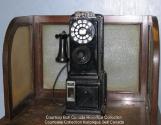2
In the early days of telephony, people would ask the owner of a phone to place a call, initially it would be free, but that didn't last. Businesses started to charge for calls so telephone companies decided to take over this economic opportunity. Coin collectors were developed so that when a coin, such as when a five-cent was deposited it would ring a bell, a dime would strike the bell twice and a quarter would strike a gong. Since there was no connection between coin collectors and phone, bells and gongs produced a sound loud enough for the operator to hear it.The coin collector shown here is associated with a 1917 magneto phone in a wooden phone booth.
3
Pay Station - Model 50HCirca 1930
Throughout Canada and USA
 Credits:
Credits:Bell Canada Historical Collection
4
A rotary dial pay phone of the late 1920s as likely to have been seen in a hotel lobby. The pay phone to be complete needed an external subset where the bells and network were housed. This pay phone had small transmitters located near the bell and gong so the operator could hear the coins being deposited when a long distance call was placed. Local calls were made without the operator's intervention because a switch was activated in the phone when a coin was deposited, this switch permitted dialling.In order to operate the coin features, equipment in the telephone office provides dial tone access when coin is deposited plus coin collect and return for operator assisted calls.
6
The NE-233A coin collector is similar to the pay phone of the thirties except for the handset. It was plagued by fraud, paper stuffed into the coin return chute would prevent the coins from being returned to the customer, the thief would then remove paper to retrieve the returned coins. A door over the return compartment solved the problem. When calls cost a dime, a hole would be drilled near the edge and a thread attached so the coin could be retrieved, a mechanism was added below the coin entry slots to prevent retrieval.Fraud became a serious issue with the advent of portable cassette recorders of the 1970s. A person would record the gong sound of a quarter being deposited repeatedly, then play back the recorder to the operator when asked to deposit for example four quarters. This problem could not be overcome without direct surveillance which was impractical. A new solution had to be found.
8
The Centurion pay phone was designed by Northern in 1973 to overcome the fraud problems of the previous generation payphones. Gone were the bell and gong, coins deposited via a single slot were identified to equipment or operator by a non reproducible coded signal. In addition it was difficult with the older payphones to determine, from a distance, if the cash box had been stolen. The Centurion had a coloured plastic covering that had to be removed to access the cash box, once removed the payphone's bright orange metal housing was revealed. This made it highly visible from a distance.9
Millennium Credit-Card Payphone Terminal1991
Throughout Canada and USA
 Credits:
Credits:Telecommunications Museum
10
The Millennium credit card reader terminal was designed to accept credit cards. It has a display screen for prompting user. It also has the ability to monitor various functions and report failures to the telephone company.With the proliferation of cell phones payphones are no longer as prevalent as previously. Will they still be around in a few years?


